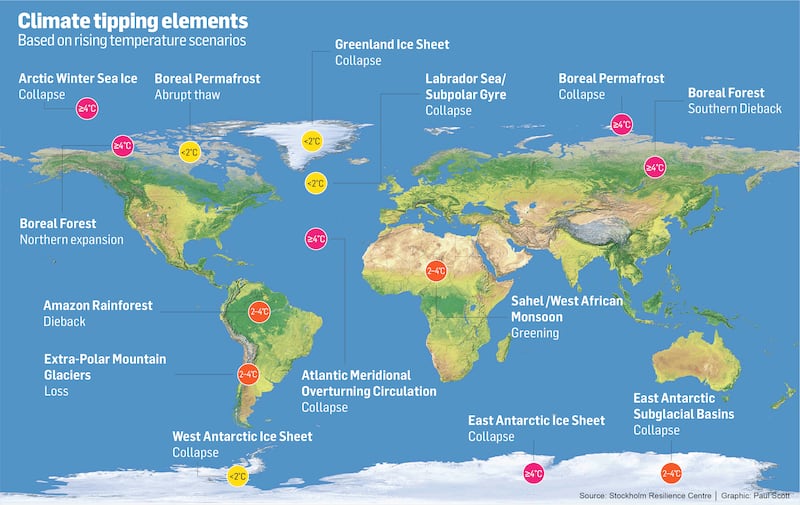Multiple climate tipping points could be triggered if global temperature rises beyond 1.5 degrees above pre-industrial levels, according to a new analysis published in the journal Science.
Even at current levels of global heating, the world is already at risk of passing five dangerous climate tipping points — while risks increase with each tenth of a degree of further warming, leading climate scientists confirm.
An international research team examined the evidence for tipping points, their temperature thresholds, timescales, and impacts from a review of more than 200 papers published since 2008 when climate tipping points were first rigorously defined. They have increased the list of potential tipping points from nine to 16.

The researchers conclude that “human emissions have already pushed Earth into the tipping points danger zone, and five of the 16 may be triggered at today’s temperatures. These are the Greenland and West Antarctic ice sheets, widespread abrupt permafrost thaw, the collapse of convection in the Labrador Sea, and massive die-off of tropical coral reefs.
READ MORE
[ Climate at risk of crossing critical ‘tipping points’ sooner than expected — study ]
[ Climate system Q&A: What are the ‘tipping points’? ]
Four of these move from “possible events to likely” at 1.5 degrees of global warming, with five more becoming possible around this level of heating.
Lead author David Armstrong McKay from Stockholm Resilience Centre, University of Exeter and the Earth Commission said: “We can see signs of destabilisation already in parts of the west Antarctic and Greenland ice sheets, in permafrost regions, the Amazon rainforest, and potentially the Atlantic [Meridional] overturning circulation [AMOC] as well.”
Ireland’s benign climate
This large system of ocean currents carries warm water from the tropics northwards into the north Atlantic — and is a major factor in Ireland’s relatively benign climate.
“The world is already at risk of some tipping points. As global temperatures rise further, more tipping points become possible,” added Dr Armstrong McKay.
“The chance of crossing tipping points can be reduced by rapidly cutting greenhouse gas emissions, starting immediately,” he said.
The sixth assessment report of the UN Intergovernmental Panel on Climate Change (IPCC) published last year stated risks of triggering climate tipping points become high by about 2 degrees above preindustrial temperatures — and very high by 2.5-4 degrees.
This new analysis, however, indicates Earth may have already left a “safe” climate state when temperatures exceeded approximately 1-degree warming. A conclusion of the research is therefore that even the UN Paris Agreement goal to limit warming to “well below 2 degrees and preferably 1.5 degrees” is not enough to fully avoid dangerous climate change.
Based on this assessment, tipping point likelihood increases markedly in the “Paris range” of 1.5-2 degrees of warming — with even higher risks beyond 2 degrees. Average global warming is between 1.1 and 1.2 degrees above the 1850-1900 level.
The study, however, provides strong scientific support for the Paris Agreement and associated efforts to limit global warming to 1.5 degrees, because it shows the risk of tipping points escalates beyond this level.
To have a 50 per cent chance of achieving 1.5 degrees and thus limiting tipping point risks, global greenhouse gas emissions must be cut by half by 2030, reaching net zero by 2050.
Co-author Tim Lenton, director of the Global Systems Institute, said that since he first assessed climate tipping points in 2008 the list had grown “and our assessment of the risk they pose has increased dramatically”.
Tipping points
He highlighted the potential to cross tipping points where change becomes self-sustaining. “That means even if temperature stops rising, once the ice sheet, ocean or rainforest has passed a tipping point it will carry on changing to a new state. How long the transition takes varies from decades to thousands of years depending on the system.”
Ecosystems and atmospheric circulation patterns can change quickly, while ice sheet collapse is slower but leads to unavoidable sea level rise which, ultimately, could be several metres.
The researchers categorised tipping elements into nine systems that affect the entire Earth system, such as Antarctica and the Amazon rainforest, and a further seven systems that if tipped would have profound regional consequences. The latter includes the west African monsoon and the death of most coral reefs around the equator. Several new tipping elements such as Labrador Sea convection and east Antarctic subglacial basins have been added compared to the 2008 assessment.
Dr Armstrong McKay stressed they had made a first step towards updating the world on tipping point risks but there was an urgent need for deeper international analysis, especially on tipping element interactions.












